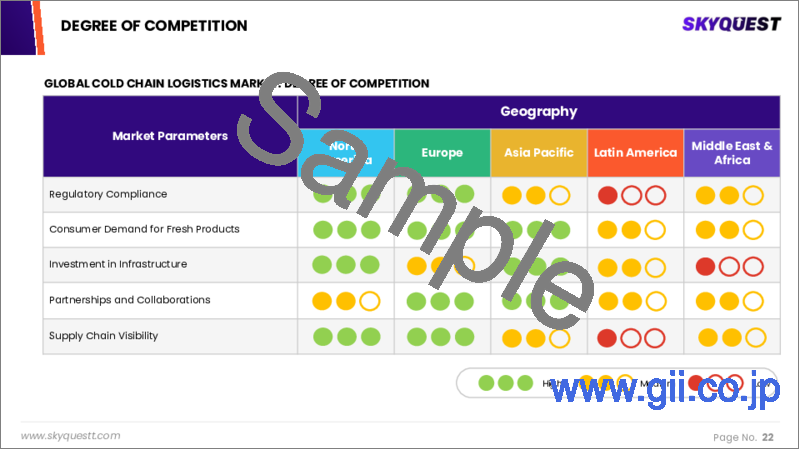|
|
市場調査レポート
商品コード
1544174
コールドチェーン物流の市場規模、シェア、成長分析:タイプ別、技術別、用途別、地域別 - 産業予測、2024年~2031年Cold Chain Logistics Market Size, Share, Growth Analysis, By Type, By Technology, By Application, By Region - Industry Forecast 2024-2031 |
||||||
|
|||||||
| コールドチェーン物流の市場規模、シェア、成長分析:タイプ別、技術別、用途別、地域別 - 産業予測、2024年~2031年 |
|
出版日: 2024年08月24日
発行: SkyQuest
ページ情報: 英文 197 Pages
納期: 3~5営業日
|
- 全表示
- 概要
- 目次
世界のコールドチェーン物流の市場規模は、2022年に2,802億5,000万米ドルとなり、2023年の3,239億7,000万米ドルから、2031年までには1兆331億6,000万米ドルに達すると予測され、予測期間(2024年~2031年)のCAGRは15.60%です。
コールドチェーン物流は、製品の賞味期限を延長する上で重要な役割を果たし、プロバイダーが新たな市場にアクセスし、現地の需要を満たすことを可能にします。このロジスティクス・アプローチには、在庫精度の向上、サイクルタイムの短縮、サプライチェーン効率の改善、運用コストの削減、汚染や腐敗を最小限に抑えることによる製品の賞味期限の延長など、いくつかの利点があります。コールドチェーン物流の重要性が高まっている背景には、進化する世界経済と、生鮮食料品、製造品、医薬品、生鮮食品などの温度に敏感な製品に対する需要の高まりがあります。コールドチェーン物流には、温度管理された倉庫や断熱された配送車両などのコンポーネントが含まれ、商品の安全な輸送と保存を保証します。政府の補助金は、サービス・プロバイダーの新興市場への参入を促進し、輸送ソリューションのイノベーションを促進しています。生鮮品に対する需要の高まりと、eコマース食品・飲料セクターの迅速な配送ニーズに伴い、コールドチェーン事業は大幅な成長を遂げています。
目次
イントロダクション
- 調査の目的
- 定義
- 市場範囲
調査手法
- 情報調達
- 二次・一次情報源
- 市場規模予測
- 市場の前提条件と制限
エグゼクティブサマリー
- 市場概要見通し
- 供給需要動向分析
- セグメント別機会分析
市場力学と見通し
- 市場力学
- 促進要因
- 機会
- 抑制要因
- 課題
- ポーターの分析
主要な市場の考察
- 市場の主要な成功要因
- 競合の程度
- 主要な投資機会
- 市場魅力度指数
- エコシステムマッピング
- 技術分析
- 価格分析
- 市場動向分析
- サプライチェーン分析
- 特許分析
- 貿易分析
- ケーススタディ分析
コールドチェーン物流市場:技術別
- 市場概要
- ブラストフリーズ
- 蒸気圧縮
- プログラマブルロジックコントローラ
- 蒸発冷却
- 極低温冷却
- その他の技術
コールドチェーン物流市場:タイプ別
- 市場概要
- コールドチェーンストレージ・インフラストラクチャ(レンタル)
- 冷蔵輸送
- 冷蔵道路輸送
- 冷蔵LCV(バン)
- 冷蔵輸送MHCV(トラック)
- 冷蔵HCV
- トレーラー
- セミトレーラー
- 冷蔵海上輸送
- 冷蔵鉄道輸送
- 冷蔵航空輸送
- その他
- 在庫管理
- 注文履行
- 品質管理・保証
- 付加価値サービス
- クロスドッキング
- 温度監視・レポート
- カスタマイズされたソリューション
コールドチェーン物流市場:用途別
- 市場概要
- 食品・飲料
- 乳製品・冷凍デザート
- 魚、肉、シーフード製品
- 果物と野菜
- ベーカリー製品・菓子類製品
- その他
- 医薬品
- その他の用途
- 化学薬品
- 花・植物
- 美術
- エレクトロニクス
- その他の温度に敏感な製品
コールドチェーン物流市場:温度タイプ別
- 冷蔵(0℃~5℃)
- 冷凍(-18℃以下)
- 急速冷凍(-25℃以下)
コールドチェーン物流市場規模:地域別
- 市場概要
- 北米
- 米国
- カナダ
- 欧州
- ドイツ
- 英国
- フランス
- イタリア
- スペイン
- その他欧州地域
- アジア太平洋
- 中国
- インド
- 日本
- 韓国
- その他アジア太平洋
- ラテンアメリカ
- ブラジル
- その他ラテンアメリカ地域
- 中東・アフリカ(MEA)
- GCC諸国
- 南アフリカ
- その他中東・アフリカ地域
競合情勢
- 上位5社の比較
- 主要企業の市場ポジショニング(2023年)
- 主要な市場企業が採用した戦略
- 市場における最近の活動
- 主要企業の市場シェア(2023年)
主要企業プロファイル
- AMERICOLD LOGISITCS INC.
- LINEAGE INC.
- NICHIREI CORP.
- Swire Group(China)
- BURRIS LOGISITCS
- United Parcel Service, Inc.(United States)
- FedEx Corporation(United States)
- AGRO Merchants Group(United States)
- Kloosterboer(Netherlands)
- Americold Realty Trust(United States)
- XPO Logistics, Inc.(United States)
- Preferred Freezer Services, LLC(United States)
- VersaCold Logistics Services(Canada)
- MSC Mediterranean Shipping Company S.A.(Switzerland)
- C.H. Robinson Worldwide, Inc.(United States)
- NewCold Advanced Cold Logistics(Netherlands)
- SSI SCHAEFER(Germany)
- Interstate Cold Storage, Inc.(United States)
- Kloosterboer Group(Netherlands)
- Henningsen Cold Storage Co.(United States)
- Agro Merchants Group, LLC(United States)
Global Cold Chain Logistics Market size was valued at USD 280.25 Billion in 2022 and is expected to grow from USD 323.97 Billion in 2023 to reach USD 1033.16 Billion by 2031, at a CAGR of 15.60% during the forecast period (2024-2031).
Cold chain logistics play a crucial role in extending the shelf life of products, allowing providers to access new markets and meet substantial local demand. This logistics approach offers several benefits, including enhanced inventory accuracy, reduced cycle times, improved supply chain efficiency, lower operational costs, and extended product shelf life by minimizing contamination and spoilage. The increasing importance of cold chain logistics is driven by the evolving global economy and the growing demand for temperature-sensitive products, such as fresh produce, manufactured goods, pharmaceuticals, and perishable food items. Cold chain logistics involve components like temperature-controlled warehouses and insulated delivery vehicles, ensuring the safe transport and preservation of goods. Government subsidies have facilitated the entry of service providers into emerging markets, fostering innovation in transportation solutions. With the rising demand for perishable goods and the expedited delivery needs of the e-commerce food and beverage sector, cold chain operations have experienced substantial growth.
Top-down and bottom-up approaches were used to estimate and validate the size of the Global Cold Chain Logistics market and to estimate the size of various other dependent submarkets. The research methodology used to estimate the market size includes the following details: The key players in the market were identified through secondary research, and their market shares in the respective regions were determined through primary and secondary research. This entire procedure includes the study of the annual and financial reports of the top market players and extensive interviews for key insights from industry leaders such as CEOs, VPs, directors, and marketing executives. All percentage shares split, and breakdowns were determined using secondary sources and verified through Primary sources. All possible parameters that affect the markets covered in this research study have been accounted for, viewed in extensive detail, verified through primary research, and analyzed to get the final quantitative and qualitative data.
Global Cold Chain Logistics Market Segmental Analysis
Global Cold Chain Logistics Market is segmented based on type, temperature, application, technology and region. Based on type, the market is segmented into storage, transportation, packaging and monitoring components. Based on temperature market is segmented into chilled, frozen and deep frozen. Based on application, market is segmented into food & beverages, pharmaceuticals and others. Based on technology market is segmented into, Blast freezing, vapor compression, programmable logic controller, evaporative cooling, cryogenic technologies, others. Based on region, the market is segmented into North America, Europe, Asia Pacific, South America and Middle East and Africa.
Drivers of the Global Cold Chain Logistics Market
Globalization has significantly increased international trade, particularly in the import and export of perishable goods. To address the need for fresh products across borders, it is crucial to have efficient cold chain logistics systems in place. This involves seamless coordination among suppliers, transportation providers, and customs authorities to ensure timely deliveries and adherence to international regulations. To meet the growing demand for fresh goods globally, well-organized cold chain logistics networks are essential. They help manage the complex requirements of cross-border trade, including maintaining product quality and meeting regulatory standards, thereby facilitating the smooth and timely distribution of perishable items.
Restraints in the Global Cold Chain Logistics Market
Building and sustaining a dependable cold chain logistics infrastructure can be particularly challenging in developing regions or remote areas. These areas may face limitations in access to adequate cold storage facilities, efficient transportation networks, and skilled personnel. Without proper infrastructure, there is a heightened risk of delays, product spoilage, and compromised quality throughout transportation and storage. The lack of sufficient cold chain infrastructure can significantly impact the efficiency and effectiveness of logistics operations. In regions with limited resources, ensuring the integrity of perishable goods during transit and storage becomes more difficult, potentially leading to increased losses and reduced product quality.
Market Trends of the Global Cold Chain Logistics Market
The rising consumer demand for fresh and organic food products is driving an increased need for cold chain logistics services. Consumers are increasingly seeking high-quality food items that offer extended shelf life and superior nutritional value, which necessitates efficient temperature-controlled transportation and storage solutions. As the preference for fresh and organic foods grows, so does the requirement for robust cold chain logistics. This trend emphasizes the importance of maintaining optimal temperature conditions throughout transportation and storage to meet consumer expectations for quality and freshness.
Table of Contents
Introduction
- Objectives of the Study
- Definitions
- Market Scope
Research Methodology
- Information Procurement
- Secondary & Primary Data Sources
- Market Size Estimation
- Market Assumptions & Limitations
Executive Summary
- Market Overview Outlook
- Supply Demand Trend Analysis
- Segmental Opportunity Analysis
Market Dynamics & Outlook
- Market Dynamics
- Drivers
- Opportunities
- Restraints
- Challenges
- Porters Analysis
- Competitive rivalry
- Threat of Substitute Products
- Bargaining Power of Buyers
- Threat of New Entrants
- Bargaining Power of Suppliers
Key Market Insights
- Key Success Factors of The Market
- Degree Of Competition
- Top Investment Pockets
- Market Attractive Index
- Ecosystem Mapping
- Technology Analysis
- Pricing Analysis
- Market Trend Analysis
- Supply chain analysis
- Patent analysis
- Trade analysis
- Case study analysis
Global Cold Chain Logistics Market by Technology
- Market Overview
- Blast Freezing
- Vapor Compression
- Programmable Logic Controller
- Evaporative Cooling
- Cryogenic Cooling
- Other Technologies
Global Cold Chain Logistics Market by Type
- Market overview
- Cold Chain Storage and Infrastructure (Rent)
- Refrigerated Transportation
- Refrigerated Road Transportation
- Refrigerated LCV (Van)
- Refrigerated Transportation MHCV (Truck)
- Refrigerated HCV
- Trailers
- Semitrailers
- Refrigerated Sea Transportation
- Refrigerated Rail Transportation
- Refrigerated Air Transportation
- Others
- Inventory Management
- Order Fulfillment
- Quality Control and Assurance
- Value-Added Services
- Cross-Docking
- Temperature Monitoring and Reporting
- Customized Solutions
Global Cold Chain Logistics Market by Application
- Market Overview
- Food & Beverages
- Dairy & Frozen Desserts
- Fish, Meat, and Seafood Products
- Fruits & Vegetables
- Bakery and Confectionery Products
- Others
- Pharmaceuticals
- Other Applications
- Chemicals
- Flowers & Plants
- Art
- Electronics
- Other Temperature-Sensitive Products
Global Cold Chain Logistics Market by Temperature Type
- Chilled (0°C To 5°C)
- Frozen (-18°C And Below)
- Deep-Frozen (Below -25°C)
Global Cold Chain Logistics Market Size by Region
- Market Overview
- North America
- USA
- Canada
- Europe
- Germany
- UK
- France
- Italy
- Spain
- Rest of Europe
- Asia Pacific
- China
- India
- Japan
- South Korea
- Rest of Asia-Pacific
- Latin America
- Brazil
- Rest of Latin America
- Middle East & Africa (MEA)
- GCC Countries
- South Africa
- Rest of MEA
Competitive Landscape
- Top 5 Player Comparison
- Market Positioning of Key Players, 2023
- Strategies Adopted by Key Market Players
- Recent Activities in the Market
- Key Companies Market Share (%), 2023
Key Company Profiles
- AMERICOLD LOGISITCS INC.
- Company Overview
- Business Segment Overview
- Financial Updates
- Key Developments
- LINEAGE INC.
- Company Overview
- Business Segment Overview
- Financial Updates
- Key Developments
- NICHIREI CORP.
- Company Overview
- Business Segment Overview
- Financial Updates
- Key Developments
- Swire Group (China)
- Company Overview
- Business Segment Overview
- Financial Updates
- Key Developments
- BURRIS LOGISITCS
- Company Overview
- Business Segment Overview
- Financial Updates
- Key Developments
- United Parcel Service, Inc. (United States)
- Company Overview
- Business Segment Overview
- Financial Updates
- Key Developments
- FedEx Corporation (United States)
- Company Overview
- Business Segment Overview
- Financial Updates
- Key Developments
- AGRO Merchants Group (United States)
- Company Overview
- Business Segment Overview
- Financial Updates
- Key Developments
- Kloosterboer (Netherlands)
- Company Overview
- Business Segment Overview
- Financial Updates
- Key Developments
- Americold Realty Trust (United States)
- Company Overview
- Business Segment Overview
- Financial Updates
- Key Developments
- XPO Logistics, Inc. (United States)
- Company Overview
- Business Segment Overview
- Financial Updates
- Key Developments
- Preferred Freezer Services, LLC (United States)
- Company Overview
- Business Segment Overview
- Financial Updates
- Key Developments
- VersaCold Logistics Services (Canada)
- Company Overview
- Business Segment Overview
- Financial Updates
- Key Developments
- MSC Mediterranean Shipping Company S.A. (Switzerland)
- Company Overview
- Business Segment Overview
- Financial Updates
- Key Developments
- C.H. Robinson Worldwide, Inc. (United States)
- Company Overview
- Business Segment Overview
- Financial Updates
- Key Developments
- NewCold Advanced Cold Logistics (Netherlands)
- Company Overview
- Business Segment Overview
- Financial Updates
- Key Developments
- SSI SCHAEFER (Germany)
- Company Overview
- Business Segment Overview
- Financial Updates
- Key Developments
- Interstate Cold Storage, Inc. (United States)
- Company Overview
- Business Segment Overview
- Financial Updates
- Key Developments
- Kloosterboer Group (Netherlands)
- Company Overview
- Business Segment Overview
- Financial Updates
- Key Developments
- Henningsen Cold Storage Co. (United States)
- Company Overview
- Business Segment Overview
- Financial Updates
- Key Developments
- Agro Merchants Group, LLC (United States)
- Company Overview
- Business Segment Overview
- Financial Updates
- Key Developments





